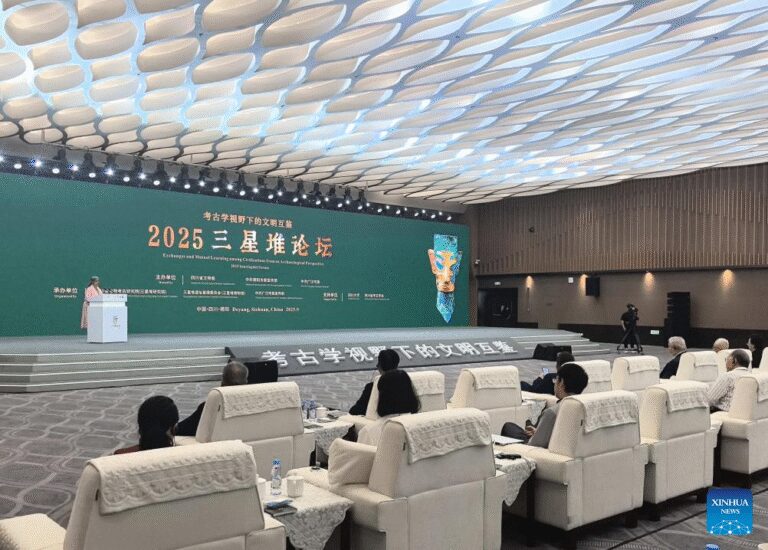
The 2025 Sanxingdui Forum is held in Deyang, southwest China’s Sichuan Province, Sept. 27, 2025.(Xinhua/Bao Feifei)
CHENGDU, Sept. 28 (Xinhua) — New archaeological findings have revealed a significant number of painted bronze artifacts at the Sanxingdui Ruins in southwest China’s Sichuan Province. This amazing discovery has extended the timeline for the emergence of painted bronze items in China by nearly a thousand years.
The findings were unveiled at the 2025 Sanxingdui Forum held on Saturday in Deyang City of Sichuan by the Sichuan provincial cultural relics and archaeology research institute.
Spanning 12 square kilometers, the Sanxingdui Ruins are believed to be the remnants of the Shu Kingdom, dating back 4,500 to 3,000 years.
About three thousand years ago, the people of Sanxingdui cast alloys of copper, tin, and lead into various images, including giant sacred trees, massive masks, and imposing deities. The latest research indicated that these bronze artifacts were adorned with brilliant colors over their golden surfaces.
Ancient bronze artifacts often have a greenish hue, which is actually the result of corrosion that occurs after being buried underground for thousands of years. This greenish tint obscures their original appearance, which was a dazzling shade of gold.
Through technological analysis, archaeologists have unveiled the “color code” of Sanxingdui’s bronze artifacts. The colors discovered so far include black and red. Black is commonly found in the eyebrows, eyes, and hair of bronze figures and masks, and is also used to depict special patterns and symbols.
Red often appears on the petals of bronze sacred trees and in the intricate grooves of bronze vessels and the clothing of figures.
These painted designs have been found on hundreds of bronze figures, mythical beasts, dragon heads, and other artifacts, some of which are even visible to the naked eye.
“It was previously believed that painted bronze artifacts in China were mostly seen during the Warring States Period (475 B.C.-221 B.C.), Qin (221 B.C.-207 B.C.) and Han (202 BC-8 AD) dynasties,” said Liu Baige, a postdoctoral researcher responsible for the findings at the Sichuan provincial cultural relics and archaeology research institute.
“The discovery, in large quantities, and with exquisite craftsmanship and natural materials from Sanxingdui, has pushed back the timeline for their emergence in China by nearly a thousand years,” said Liu.
Discovered in the late 1920s in Guanghan, Sichuan Province, the Sanxingdui Ruins are considered one of the world’s most significant archaeological discoveries of the 20th century. ■

This undated file photo shows a bronze artifact at the Sanxingdui Ruins in southwest China’s Sichuan Province.(Sichuan provincial cultural relics and archaeology research institute/Handout via Xinhua)

